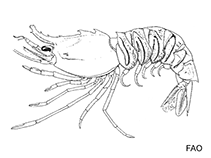Sicyonia ingentis (Burkenroad, 1938)
Ridgeback rock shrimp| Native range | All suitable habitat | Point map | Year 2050 |

|
| This map was computer-generated and has not yet been reviewed. |
| Sicyonia ingentis AquaMaps Data sources: GBIF OBIS |
Google image | No image available for this species;
drawing shows typical species in Sicyoniidae.
Classification / Names Populärnamn | synonymer | CoL | ITIS | WoRMS
Malacostraca | Decapoda | Sicyoniidae
Environment: milieu / climate zone / djupintervall / distribution range Ekologi
; djupintervall 45 - 460 m (Ref. 126804). Subtropical, preferred 20°C (Ref. 107945); 37°N - 20°N, 122°W - 105°W (Ref. 112661)
Distribution Länder | FAO områden | Ekosystem | Förekomster | Utplanteringar
Eastern Central Pacific: From Monterey Bay, USA to Nayarit, Mexico.
Length at first maturity / Size / Weight / Age
Könsmognad: Lm 9.4 range ? - ? cm Max length : 6.6 cm TL hane/ej könsbestämd; (Ref. 8); 10.5 cm TL (female)
Life cycle and mating behavior Könsmognad | Reproduktion | Lek | Eggs | Fecundity | Larvae
Main reference
referenser | Koordinator | Medarbetare
Pérez Farfante, I. and B. Kensley 1997 Penaeoid and Sergestoid shrimps and prawns of the world: keys and diagnoses for the families and genera. Mémoires du Muséum National d'Histoire Naturelle 175:1-233. (Ref. 75620)
IUCN Red List Status
(Ref. 130435: Version 2025-1)
CITES status (Ref. 108899)
CMS (Ref. 116361)
Threat to humans
Human uses
Fiskeri: kommersiell
FAO - fiskeri: landings | FishSource | Sea Around Us
Verktyg
Ytterligare information
Födosammansättning
Födointag
Predatorer
Max. ages / sizes
Length-weight rel.
Length-length rel.
Length-frequencies
Mass conversion
Abundans
Internet-källor
BHL | BOLD Systems | CISTI | DiscoverLife | FAO(fiskeri: ; publication : search) | Fishipedia | GenBank (genome, nucleotide) | GloBI | Gomexsi | Google Books | Google Scholar | Google | PubMed | Tree of Life | Wikipedia (Go, sök) | Zoological Record



